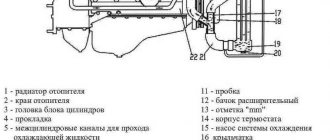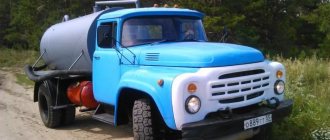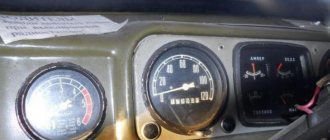More than 1.2 million GAZelle vehicles are used on Russian roads alone. In 2010, the start of production of a modified version of the model, called GAZelle Business, was announced. Replacing the regular GAZelle, which is referred to as “Classic,” has been asking for a long time. The conditions of the domestic market and increased competition due to the filling of the commercial segment with imported cars required a slightly different approach to the production of quality cars. Therefore, the Gorky Automobile Plant tried to create a new product that could become widespread, continuing the glorious traditions of GAZ.
The first steps towards creating an updated version of the model could be seen with the advent of Sobol, which was equipped with a Cummins ISF turbodiesel power unit. The same engine is used in diesel modifications of GAZelle Business. But at the same time, the new car received a modern design, an improved interior, attractive driving and dynamic characteristics. In this article we will talk about what potential car owners are most interested in – GAZelle Business fuel consumption per 100 km.
How to reduce fuel consumption on an UMZ 4216 engine
Technical characteristics of UMZ 4216, fuel consumption. This engine is a four-stroke engine, it includes four cylinders that are arranged in-line. Fuel, namely gasoline, should be filled with AI-92 or AI-95. Let's take a closer look at the technical characteristics of the UMZ 4216 for the Gazelle:
- volume is 2890 cm³;
- standard piston diameter is 100 mm;
- compression (degree) – 9.2;
- piston stroke – 92 mm;
- power – 90-110 hp
The cylinder head (cylinder head) is made of steel, namely aluminum. The weight of the Gazelle engine is about 180 kg. The engine is supplied with a power unit on which additional equipment is attached: a generator, a starter, a water pump, drive belts, etc.
Conclusion
In this article we looked at the UMZ 4216 on the Gazelle Business, where we outlined its technical characteristics in detail. If we compare this model with its predecessor, we can conclude that the unit is no different in size from the UMZ 4215. Even the parameters and properties remain the same, and the volume is 2.89 liters. This engine was for the first time strengthened with parts from foreign manufacturers.
Imported spark plugs were installed on the engine, a throttle position sensor was added, as well as fuel injectors. Thanks to this, the quality of work has improved and the service life has increased.
Power units
The GAZ-2705 was equipped with several doors for loading; the first was on the side and moved to the side, the second was located at the back and was hinged with two doors. A ventilation system draft regulator is installed in the front cover of the pusher block, which performs the function of separating oil microparticles from gases and serves to prevent dust from entering the crankcase when the draft in the intake system increases.
Alternatives
If the driver “came across” a car with a defective engine, which he has no desire to constantly repair, he can try to replace it with another one suitable for the car. There are different options for swapping an engine, but mostly those who decide to swap choose the ZMZ-405 engine. This choice is due to several reasons:
- unpretentiousness of the engine to fuel quality;
- reliability - the engine breaks down infrequently;
- it is affordable when compared with imported analogues;
- the car requires a minimum of modifications to work with this engine;
- There are many used 405, 406 engines on sale in good condition, at a price several times cheaper than a new one. And even a minor repair of a contract engine will be cheaper than buying a “fresh” unit.
The GAZelle-Business plant now regularly installs a Cummins turbodiesel power unit, but the option of replacing it with it is rarely considered due to the high cost and high sensitivity of the American engine to fuel quality, with which there are traditional problems in Russia.
Fuel consumption has increased, power has decreased and it often trips • Main characteristics of UMZ 4216
The engine has earned favor for its maximum performance, easy and quick repairs, which are carried out with a standard repair kit, after which the car will again have a high mileage. In a block with a piston diameter of 100 mm, models UMZ 4215, 4213 and 4216, the liners are pressed using special equipment, and during repairs they cannot be pressed out, therefore, if the cylinders are significantly worn, the BC must be replaced.
| Engine | Consumption (city) | Consumption (highway) | Flow (mixed) | Fuel type |
| 2.8 MT 120 hp (Mechanics) | 12 | 9,2 | 10 | Diesel |
| 2.9 MT 107 hp (Mechanics) | 14,1 | 10,7 | 11,5 | Petrol |
Engine device
UMZ-4216 is a gasoline injection engine with electronically controlled ignition and injection. Number of cylinders – 4, engine displacement 4216–2.89 liters. The unit in the basic version is capable of producing power up to 107 horsepower.
The basis for the development was the ZMZ-21 engine. The new UMP model has a similar design:
- engine valve location – top;
- the cylinder block is made of lightweight aluminum;
- Timing drive – gear;
- lower camshaft layout;
- 2 valves per engine cylinder.
The oil sump, stamped from steel, is also structurally similar.
Crankcase of Gazelle Business 4216 engines and related modifications:
As in all UMZ engines with 100 mm cylinders. in diameter, the sleeves are pressed into the BC and cannot be pressed out during repairs. If the cylinders wear out, the entire block will have to be replaced.
Main elements of the 4216 engine:
- aluminum BC, into which the above-mentioned cast iron sleeves are pressed;
- BC:
- Cylinder head, also aluminum;
- flywheel with ring gear;
- crankshaft with connecting rod (4 pieces) and main journals (5 bearings);
- pistons equipped with a single oil scraper and two compression rings;
- oil pump
- engine connecting rods;
- pushers and rods;
- engine bearings, connecting rods and main bearings;
- crankshaft pulley, hub;
- engine gaskets and seals;
- textolite camshaft gear and metal crankshaft gear.
Engine removed:
The crankshaft drives the timing belt through gears. Rods and pushrods transmit the movement coming from the camshaft to rocker arms, which operate the intake and exhaust valves.
Engine control is electronic. The engine operation is controlled by the MIKAS electronic unit, which receives signals from the TPS, shaft position sensor, knock and pressure sensors.
Sensor diagram from the official manual:
Main characteristics of UMZ 4216 – Cummins repair
| Engine 4216: characteristics, reviews. 78.5 106.8 Rated rotation speed, min -1 4000 Maximum net torque according to GOST 14846-81, N m kgf m 220.5 22.5 Rotation speed corresponding to the maximum torque, min -1 2200 2500 Fuel Automotive gasoline brands Regular-92 GOST R 51105, Regular Euro-92 GOST R 51866. Gasoline consumption declared by the manufacturer is not an absolute value and can increase significantly depending on the season of operation of the vehicle, load, and driving style. |
- air: receiver, intake manifold and throttle valve;
- fuel: injectors installed on the fuel rail.
Advantages of gas fuel • If the cooling system becomes airy, antifreeze begins to eject from the expansion tank.
Typical faults
The UMZ plant claims a service life of engines of the 4216 line of 250 thousand before the need for overhaul. In practice, faults appear earlier.
The main problems that owners of commercial vehicles with a UMP engine from the series under consideration have to face:
- high oil consumption due to waste through the piston rings;
- oil leaks;
- knocking of engine valves;
- failure of electronic sensors;
- engine overheating for various reasons.
Premature failures usually result from:
- violations of operating rules - the driver excessively “turns” the engine and overloads it, or exceeds the maximum permissible load of the machine;
- driving in difficult track conditions;
- incorrect, unqualified or untimely maintenance;
- use of poor fuel, lubricant or coolant.
Defects in the 4216 series are relatively rare, so the malfunction is most often associated with an actual breakdown, and not a factory defect, although such cases do exist.
Other possible problems:
- The engine leaks oil and liquid appears on the parts.
A possible cause is wear of the crankshaft rear oil seal. The problem often appears when driving for a long time at rpms above 2500; the 4216 is not designed to operate at very high rpms. Replacing the seals completely eliminates the problem.
- Engine vibrations, the engine “jerks” at idle or while driving.
The problem arises due to the uneven flow of the combustible mixture into the cylinders. Its causes may be malfunctions in the ignition system (plugs, coils, etc.) or injection (for example, a clogged injector). The car consumes a lot of fuel, the Check light may come on on the dashboard, and a misfire error is recorded in the ECU. In this case, a comprehensive diagnosis is required.
Technical characteristics of UMZ-4216
This motor belongs to the class:
- gasoline;
- four-stroke;
- four-cylinder;
- eight-valve.
Each such engine is equipped with a microprocessor-based integrated ignition and fuel supply control system. The injection in the UMZ-4216 models is phased. UMZ-4216 engines have liquid cooling.
Characteristics of the engine 4216
Fuel compression ratio
Cylinder volume working
4000 rpm at rated power, 2200-2500 rpm. at maximum torque
Specific fuel consumption
Maximum torque
The 4216 UMZ engine runs on AI-92 or AI-95 gasoline. The design of this model allows installation on GAZelle and gas equipment. The service life of the UMZ-4216 engine is 250 thousand kilometers. UMZ provides a three-year warranty on its engines (or 80 thousand kilometers).
The unfueled UMZ-4216 engine weighs 172 kg. The volume of the cooling system of this engine is 3.5 liters. The fuel supply in it is carried out in the form of distributed injection. The volume of the engine oil system is 5.8 liters.
Engine reviews and overview of replacement and repair prices
The average cost of replacing an engine is 10,000 rubles, and the cost of repairs is from 2,000 rubles.
Evgeniy, 37 years old, Nizhny Novgorod: “This is an engine that constantly stalls and the speed fluctuates. The only advantages I can mention are power and traction. Over the 3 years of operation, major repairs have already had to be done 2 times. On average, repairs cost 5,000-7,000 rubles.”
Georgy, 41 years old, Omsk: “This is an easy-to-maintain engine, but the fuel pump is unstable. I replaced the belts with poly V-belts, after which the engine began to run better. Among the shortcomings, I can highlight high fuel consumption.”
Real fuel consumption on the Gazelle
Parameter name Value Engine type Petrol with an integrated microprocessor control system for fuel injection and ignition, four-stroke Ecological class Euro-3 Number of cylinders 4 Cylinder operating order 1-2-4-3 Cylinder diameter, mm 100 Piston stroke, mm 92 Displacement, l 2 .89 Rated net power according to GOST 14846-81, kW l. Often the Ulyanovsk engine overheats, and drivers take various measures to get rid of this unpleasant and dangerous phenomenon for the internal combustion engine.
Owner reviews
Those who drive personal and business cars with a UMZ 4216 engine generally praise these engines. The main advantages, according to car enthusiasts:
- affordability of both the engine itself and parts for repair;
- high maintainability due to the simplicity of the device;
- quite moderate, for its characteristics, fuel consumption;
- good torque of the engine.
Many experienced car owners even do their own repairs; in general, service operations are quite simple and can be carried out almost in the field. Only the injector can cause complexity - its design, repair and adjustment are fundamentally more complicated when compared with carburetor analogues, and require special knowledge and equipment.
But there are also negative reviews. Main complaints:
- engine tendency to overheat;
- breakdown of sensors with subsequent “triple”, loss of traction and other problems;
- high oil consumption - fluid leaks, according to drivers, “from all the cracks.”
Most of the complaints are related to the fact that the driver came across a copy of the engine with a defect, which, although not so often, does happen. Typical factory defects of the 4216 series engine:
- air leakage occurs due to a cracked intake manifold;
- Oil pressure drops due to a defective pump;
- failure of the electromagnetic cooling clutch and further overheating.
There are often cases when owners, faced with problems, modify the engine themselves. For example, to combat overheating, a three-row copper radiator is installed, which replaces the standard cooling element: copper copes with its tasks better. Another popular method is to equip the engine with an electric fan, the control switch of which is brought into the cabin. If the coolant sensor shows a critical temperature, the person driving activates additional forced cooling.
Motorists note that a complete engine overhaul eliminates the bulk of “generic diseases”, provided that the work is carried out competently and using high-quality original parts.
Gasoline engines since 2010 • Engine repair UMZ 4216
| ZMZ 405 or UMZ 4216, which is better? The information will be clarified at the manufacturer and we will inform you of the engine modification that is currently being produced in order to replace your motor. Many different options can be considered for replacement, but most often owners of commercial vehicles install ZMZ-405 engines; this particular engine is chosen for a number of reasons. |
| 4216 UMZ-4216 ENGINE 02 for the Gazelle car (107 hp; GAZelle; AI-92; 170 kg) (02-20) Price. Options. Specifications. JSC Volga Motors. 4216-20 UAZ-4216. UMZ 4216 Ulyanovsk Type of oil pressure sensor Malfunction Symptom Emergency break or increase in contact resistance The signal light does not light up Contact electrodes are stuck The signal light is constantly on The signal light is damaged in the integrity of the diaphragm Low sensitivity of the sensor, the signal light goes out only at high speeds The sensor does not seal properly Oil leakage from the sensor Control break of the rheostat Absence of pressure indicator readings Increased resistance of the moving contact Low pressure readings Violation of the integrity of the diaphragm Absence of readings or low pressure readings Violation of the tightness of the sensor Oil leakage from the sensor. Model 42164-80 differs slightly from the standard motor 4216; this engine has other, special stays installed, in the upper part of which the compensators themselves are attached. |
- quite high fuel consumption;
- frequent sensor breakdowns;
- Frequent electrical problems.
Advantages and disadvantages
Unlike carburetor engines, engines with an injection control system can reduce fuel consumption, simplify and improve the quality of Gazelle engine control, and meet all requirements for the composition of exhaust gases
. There is no need to manually adjust the fuel supply system.
But there are also some disadvantages of using injection engines: a significantly high price, if they break down they cannot always be repaired, the fuel must only be of high quality. If you have little experience in repairing Gazelle cars, it requires constant contact with special service stations, which leads to additional costs.
Technical characteristics of the UMZ 4216 engine
Engine 4216 is a four-stroke, in-line four-cylinder, 8-valve. The internal combustion engine is designed to run on AI-92 gasoline; the use of higher quality fuel, for example, AI-95 gasoline, is allowed. The technical characteristics of the engine modification UMZ-42164 (Euro-4) are as follows:
- volume – 2890 cm³;
- diameter of standard pistons – 100 mm;
- compression ratio (compression in cylinders) – 9.2;
- piston stroke – 92 mm;
- power – 107 l. With.;
- The engine cooling system is liquid (filled with antifreeze or antifreeze).
The block and cylinder head are cast from aluminum alloy. The engine of the first complete set weighs 177 kg, the engine package includes the power unit itself, and it is also equipped with attachments:
- starter;
- generator;
- intake manifold (receiver);
- ignition module with wires and tips;
- drive belts;
- water pump;
- crankshaft pulley;
- clutch basket and disc;
- ECM sensors.
According to factory standards, the fuel consumption of the Gazelle with the Ulyanovsk internal combustion engine is 10 l/100 km on the highway outside the city, in mixed mode it is 11 l/100 km. In practice, more gasoline is usually consumed, a lot depends on:
- depending on vehicle load;
- speed limit;
- period of operation (in winter, more fuel is consumed to heat up).
The UMZ 42164-80 modification engine is equipped with hydraulic compensators; this engine is equipped with Sobol Business and Gazelle Business commercial vehicles. Model 42164-80 differs little from the standard motor 4216 - this engine has other, special stays, in the upper part of which the compensators themselves are attached.
Crankshaft 4216 consists of four connecting rod journals and five main connecting rod journals, and has the following diameters:
- molar necks – 64 mm;
- connecting rod journals – 58 mm.
All journals are equipped with two steel-babbit liners; the factory tolerance for crankshaft dimensions is 0.013 mm. During the repair of a Ulyanovsk engine, the main and connecting rod journals are measured with a micrometer - if they are worn more than 0.05 mm, the shaft must be ground. The diameter of the piston pins is 25 mm, the pins are installed in bronze bushings of the connecting rods. Over time, both the pins themselves and the bushings may wear out; if play appears in the connection, the parts must be replaced.
The crankshaft in the cylinder block is mounted on supports with covers that are tightened with bolts with a certain force. Each cover has its own place - they cannot be mixed up, especially not picked up from another BC. Also, the covers must be secured to the lock - if they are installed incorrectly, the crankshaft may not turn (it will get jammed), and even if the shaft does turn, the engine will quickly fail.
Maintenance and repair
Maintenance of the 4216 Euro-3 GAZelle engine includes operations such as:
- Cleaning the power unit from dirt using a rag.
- External inspection of the crank device and gas distribution mechanism for damage and defects.
- Checking the tightness of connections and eliminating leaks of working fluid from the cooling system.
- Changing the engine oil.
- Adjusting valve clearances.
- Checking the pressure level in the power system.
- Checking the tightening torque of fasteners.
- Cleaning filter elements and replacing worn mechanisms.
- Check the motor for extraneous noise during operation.
Error codes
Engine fault codes:
| 111 | The system control module is not working correctly |
| 115 | Malfunctions of the sensor that reflects the number of engine revolutions at idle |
| 143 | Low oil pressure level |
| 146 | High coolant temperature |
| 151 | The cooling system does not reach the required temperature |
| 197 | Insufficient amount of liquid in the cooling system |
| 214 | Oil overheating |
| 233 | Low pressure level of the liquid used for cooling, pump malfunction |
| 234 | Increased engine speed |
| 235 | Increased diesel fuel temperature |
| 245 | Fan Circuit Low Voltage |
| 261 | Incorrect operation of the pumping mechanism |
| 275 | High pressure valve malfunction |
| 281 | Malfunction of power supply injectors |
| 351 | Insufficient oil pressure |
If it twitches while moving
The reason that the power unit jerks while driving may be clogged flexible durite hoses that supply gasoline to the pumping mechanism. In this case, it is recommended to blow out the hose or replace it with a new one.
This malfunction may also be caused by a dirty carburetor intake filter. In this case, it is recommended to unscrew the plug from the filter element, rinse it thoroughly and blow it out using a stream of compressed air.
If the holder of the vane valve of the gasoline pump is broken, then this valve should be replaced with a new one. It is recommended to check the traction of the cylinder head heads and, if necessary, tighten the fastening mechanisms.
It won’t start: reasons and what to do
If the power unit starts poorly when hot or there is no spark, then it is recommended:
- Adjust the gaps between the valve stem tips and the rocker arm pressure bolts.
- Unscrew the cylinder head and grind the valves.
- Inspect the ignition system for defects.
- Tighten the ignition system and carburetor mounting bolts.
- Remove the fuel and cooling system jets, rinse and blow them with compressed air.
- Dismantle the carburetor, remove the mixing chamber, unscrew the fuel system nozzle and idle screw, and blow out the channels with compressed air.
- Replace the crankshaft oil seal with a new one.
Why does the engine get hot?
Overheating of the motor may be due to weakened tension in the fan drive belt of the water pump mechanism. In this case, the belt tension should be adjusted or replaced.
If the engine starting system is not working, you need to install an earlier ignition.
The cause of the malfunction may be high temperature in the cooling system. If the coolant boils, it is recommended to flush the system and clean the filter elements from accumulated scale.
You should also check the level of the cooling fluid and, if necessary, add it to the required minimum level.
Why doesn't the fan turn on?
Electric fan malfunction may be caused by:
- failure of the electric motor;
- violation of the integrity of the wiring;
- unreliable contact in the system connectors.
If the fuse is lit, the fan stops working.
If a malfunction is detected, worn brushes and wires should be replaced, short circuits in the windings of the rotor part should be eliminated, and an external inspection of the safety device should be carried out for damage and defects.
It is recommended to diagnose the fan sensor.
To do this, you need to disconnect it from the injector and check the emergency fan switching on. If the sensor does not respond to shutdown, it should be replaced.
Replacing the alternator belt
In order to replace the belt on a GAZelle Business 4216, you need to prepare the following tools:
- a set of wrenches to remove the generator;
- new belt;
- kernel;
- mounting blade;
- protective gloves for installing a new mechanism.
Step-by-step instruction:
- Remove the old belt using a knife.
- Turn the generator set mounting bolt from below 3-4 turns.
- We press the generator forward until the ear is positioned behind the bracket.
- We fix the position of the generator.
- We put a new belt on the pulley.
- Turn the shaft using a wrench.
- We tighten all fasteners.
- We return the generator to its original position.
Replacing the pan gasket
In order to replace the gasket on the pan, remove the protective casing from the crankcase using a 13mm wrench. Then warm up the power unit at idle, and then open the crankcase cover and drain all the oil from it.
Using a 10mm wrench, unscrew the mounting bolts, after which you can remove the pan on the GAZelle. Then we dismantle the old gasket and install a new one, which must first be lubricated with oil.
We install the pan in place and tighten all the fasteners back, fill in the oil liquid. At the end, it is recommended to start the engine and check the functionality of the entire system.
A little history. Main characteristics of UMZ 4216
The first sample was the carburetor UMZ 4215, and a year later engineers created the 4216 engine, equipped with fuel injection and subject to the Euro 2 standard. As a result of overheating, the head gasket often breaks through; changing the cylinder head is generally not difficult, and drivers often make such repairs on their own.
| Parameter name | Meaning |
| engine's type | Gasoline with an integrated microprocessor control system for fuel injection and ignition, four-stroke |
| Environmental class | Euro-3 |
| Number of cylinders | 4 |
| Cylinder operating order | 1-2-4-3 |
| Cylinder diameter, mm | 100 |
| Piston stroke, mm | 92 |
| Working volume, l | 2,89 |
| Rated net power according to GOST 14846-81, kW (hp) | 78,5 (106,8) |
| Rated rotation speed, min -1 | 4000 |
| Maximum net torque according to GOST 14846-81, N m (kgf m) | 220,5 (22,5) |
| Rotation speed corresponding to maximum torque, min -1 | 2200…2500 |
| Fuel | Automobile gasoline brands "Regular-92" GOST R 51105, "Regular Euro-92" GOST R 51866. Duplicate "Premium-95" GOST R 51105 and "Premium Euro-95" GOST R 51866. |
| Exhaust system | Customized |
| Weight of the engine not filled with lubricant, kg | 172…182 |
UMZ-421
Characteristics of the UMZ-421 engine
* - for engines UMZ-4218.10, UMZ-421.10, UMZ-4215.10-10 ** - for engines UMZ-4216.10, UMZ-42161.10, UMZ-42164.10, UMZ-421647.10, UMZ-42167.10
Malfunctions and repairs of the Hunter / Loaf / Gazelle UMZ-421 engine
The UMZ-421 engine is the most modern generation of the GAZ-21 engine, along the UMZ line. The logical development of the UMZ-417 model, with an increased volume, enlarged exhaust valves (from 36 mm to 39 mm), the latest versions of the 421 have a fuel injection system. To understand, we need to make it clear that the engines of the GAZ-21 family have two branches of development - ZMZ and UMP. At the Zavolzhsky Motor Plant, ZMZ-24 was created from the 21st, and then ZMZ-402. In Ulyanovsk, based on the GAZ-21 engine, UMZ-451, UMZ-414, UMZ-417 and the latest version UMZ-421 were developed. All these engines have no significant design differences between each other. Unlike the ZMZ-402, the UMZ-421 has dry thin liners (they were wet) and due to this increased block strength, a cylinder diameter of 100 mm (92 mm on the 402), pistons with a pin offset of 7 mm, instead of the outdated packing, which I got all the owners of ZMZ engines, now a rubber cuff and other smaller parts have been used. There are no global design changes, the same engine of the 1956 model, slightly brought to mind. The engine does not have hydraulic compensators and every 10,000 km you need to adjust the valve clearances; in this regard, the engine is no different from the 402 engine.
Modifications of the UMZ 421 engine
1. UMZ 4218.10 - main engine, SZh 7 for 76 gasoline. Power 98 hp Compliance with environmental requirements Euro-1. Used on UAZ vehicles. 2. UMZ 4218.10-10 - analogue of UMZ 4218.10, increased coolant to 8.2 for 92 gasoline. Power 103 hp Used on UAZ commercial vehicles. 3. UMZ 421.10 - analogue of UMZ 4218.10. The exhaust system has been changed. Used on UAZ vehicles. 4. UMZ 421.10-30 - analogue of UMZ 4218.10-10. The exhaust system has been changed. Used on UAZ vehicles. 5. UMZ 4213.10-40 - analogue of UMZ-421.10-30, injector. Compliance with environmental requirements Euro-3. Power 117 hp Used on SUVs. 6. UMZ 4213.10-50 - analogue of UMZ-4213.10-40. Used on trucks. 7. UMZ 4215.10-10 - analogue of UMZ-4218.10. Used on Gazelle cars. 8. UMZ 4215.10-30 - analogue of UMZ-4218.10-10. Used on Gazelle cars. 9. UMZ 4216.10 - analogue of UMZ 40215.10-30, injector, increased coolant to 8.8 for 92 gasoline. Power 123 hp Compliance with environmental requirements Euro-3. Used on Gazelle cars. 10. UMZ 42161.10 - analogue of UMZ 4216.10. Power 99 hp Used on Gazelle-Economy cars. 11. UMZ 42164.10 - analogue of UMZ 4216.10, different camshaft. Compliance with environmental requirements Euro-4. Power 125 hp Used on Gazelle cars. 12. UMZ 421647.10 - analogue of UMZ 42164.10, gas-gasoline. Power 100 hp Used on Gazelle cars. 13. UMZ 42167.10 - analogue of UMZ 4216.10, gas-gasoline. Power 123 hp Used on Gazelle cars.
Malfunctions of UMZ 421 engines
The malfunctions of the UMZ-421 engine completely repeat the problems and shortcomings of the ZMZ-402 engine because the engines, by and large, are the same. Only the problem with the packing has been solved, otherwise there are still the same vibrations, jerking, the same tendency to overheat, knocking, constant fiddling with adjusting the valves, etc. There is nothing to talk about here for a long time - the design is 60 years old, the motor is high-torque, this is good, but outside the window is the 21st century... We read about the malfunctions HERE.
Engine tuning Hunter / Bukhanka / Gazelle UMZ-421
Turbo UMZ 421. Compressor
Considering the cars using the 421 engine, there is not the slightest point in discussing atmospheric tuning here (imagine a Gazelle on throttles), so we will talk about supercharging, but not about a 35 garrett on forging, but a calm city turbo. So, we leave the shafts as standard, the piston is standard, we modify the cylinder head, channels, combustion chambers, we grind, we buy a small 17th Garrett with an intercooler, we cook a manifold for it, we buy Subaru 440 cc injectors, a direct-flow exhaust on a 63 pipe, we configure and get tractor engine, with low power, but with good torque.
vote
Article rating
Fuel consumption GAZ GAZelle restyling 2003, bus, 1st generation, 3221 • Engine repair UMZ 4216
| Gazelle Business engine UMZ 4216 - fuel consumption At medium engine speeds and when the car was moving at a speed of 60 km h, the coolant temperature was normal, but as soon as you reduced the speed or got into a traffic jam, the 4216 engine rapidly gained temperature, until the coolant boiled liquids. Model 42164-80 differs slightly from the standard motor 4216; this engine has other, special stays installed, in the upper part of which the compensators themselves are attached. |
- the intake manifold cracks and begins to suck in air;
- the pump does not provide the required oil pressure;
- the electromagnetic cooling clutch refuses to work, and the motor begins to overheat.
How to determine fuel consumption
What do the numbers depend on?
Fuel consumption standards for the Gazelle. They are recorded in liters per 100 km. The values provided by the manufacturer are conditional, since everything depends on the internal combustion engine model and driving method. If you look at what the manufacturer offers us, the internal combustion engine is 10 l/100 km. And the average fuel consumption on the highway for the Gazelle will range from 11-15 l/100 km.
As for the internal combustion engine model we are considering, the gasoline consumption of the Gazelle Business UMZ 4216 per 100 km is 10-13 liters, and the real fuel consumption of the Gazelle 4216 per 100 km is 11 to 17 liters.
How to measure consumption
Typically, a car’s fuel consumption is measured under conditions such as: a flat road without holes or bumps and an appropriate speed. Manufacturers themselves do not take into account many factors when measuring RT, for example: gasoline consumption, or how warm the engine is, or the load on the car. Manufacturers often provide a figure lower than the real one.
In order to better find out what the exact fuel consumption is and how much it needs to be poured into the fuel tank, you need to add 10-20% of this figure to the resulting figure. Cars have different engine models, therefore, their standards are also different.











